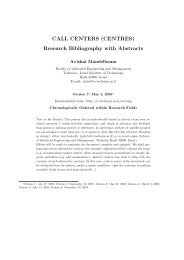Uncertainty in the Demand for Service - Faculty of Industrial ...
Uncertainty in the Demand for Service - Faculty of Industrial ...
Uncertainty in the Demand for Service - Faculty of Industrial ...
Create successful ePaper yourself
Turn your PDF publications into a flip-book with our unique Google optimized e-Paper software.
to as <strong>the</strong> Erlang-C <strong>for</strong>mula. It is denoted E2,N and is given by<br />
E2,N = <br />
j≥N<br />
πN = (λ/µ)N<br />
<br />
N−1 (λ/µ)<br />
N!(1 − ρ)<br />
i=0<br />
i<br />
−1 (λ/µ)N<br />
+<br />
i! N!(1 − ρ)<br />
The Poisson distribution <strong>of</strong> arrivals has an important and useful consequence, known as PASTA<br />
(Poisson Arrivals See Time Averages): it implies that <strong>the</strong> probability E2,N is <strong>in</strong> fact also <strong>the</strong><br />
probability that a customer is delayed <strong>in</strong> <strong>the</strong> queue (as opposed to be<strong>in</strong>g served immediately<br />
upon arrival).<br />
Us<strong>in</strong>g <strong>for</strong>mula (2) and its relatives, one can calculate staff<strong>in</strong>g levels N <strong>for</strong> any desired service<br />
level, given <strong>the</strong> arrival rate and average service time. This can be easily done even with<br />
a spreadsheet. However, such a solution does not provide any <strong>in</strong>sight on <strong>the</strong> dependence <strong>of</strong><br />
N on model parameters, <strong>for</strong> example, how should N change if <strong>the</strong> load was doubled. Such<br />
<strong>in</strong>sight comes out <strong>of</strong> a staff<strong>in</strong>g rule that goes back to as early as Erlang [3], where he derived<br />
it via marg<strong>in</strong>al analysis <strong>of</strong> <strong>the</strong> benefit <strong>of</strong> add<strong>in</strong>g a server. (Erlang <strong>in</strong>dicated that <strong>the</strong> rule had<br />
been practiced actually s<strong>in</strong>ce 1913.) This is <strong>the</strong> square-root safety- staff<strong>in</strong>g rule, which we now<br />
describe.<br />
Let R = λ/µ denote <strong>the</strong> average <strong>of</strong>fered load. Then <strong>the</strong> square root safety-staff<strong>in</strong>g rule states<br />
<strong>the</strong> follow<strong>in</strong>g: <strong>for</strong> moderate to large values <strong>of</strong> R, <strong>the</strong> appropriate staff<strong>in</strong>g level is <strong>of</strong> <strong>the</strong> <strong>for</strong>m<br />
5<br />
(2)<br />
N = R + β √ R (3)<br />
where β is a positive constant that depends on <strong>the</strong> desired level <strong>of</strong> service; β will be refereed to<br />
as <strong>the</strong> Quality-<strong>of</strong>-<strong>Service</strong> (QOS) parameter: <strong>the</strong> larger <strong>the</strong> value <strong>of</strong> β, <strong>the</strong> higher is <strong>the</strong> service<br />
quality. The second term on <strong>the</strong> right side <strong>of</strong> (3) is <strong>the</strong> excess (safety) capacity, beyond <strong>the</strong><br />
nom<strong>in</strong>al requirement R, which is needed <strong>in</strong> order to achieve an accepted service level under<br />
stochastic uncerta<strong>in</strong>ty.<br />
The <strong>for</strong>m <strong>of</strong> (3) carries with it a very important <strong>in</strong>sight. Let ∆ = β √ R denote <strong>the</strong> safety<br />
staff<strong>in</strong>g level (above <strong>the</strong> m<strong>in</strong>imum R = λ/µ.) Then, if β is fixed, an n-fold <strong>in</strong>crease <strong>in</strong> <strong>the</strong><br />
<strong>of</strong>fered load R requires that <strong>the</strong> safety staff<strong>in</strong>g ∆ <strong>in</strong>creases by only √ n-fold, which constitutes<br />
significant economies <strong>of</strong> scale.<br />
What does (3) guarantee as far as QOS is concerned? For Erlang-C, this is <strong>the</strong> subject <strong>of</strong><br />
<strong>the</strong> sem<strong>in</strong>al paper by Half<strong>in</strong> and Whitt [7], where <strong>the</strong>y provided <strong>the</strong> follow<strong>in</strong>g answer:<br />
Theorem 1: Consider a sequence <strong>of</strong> M/M/N queues, <strong>in</strong>dexed by N=1,2. . . As <strong>the</strong> number <strong>of</strong><br />
servers N grows to <strong>in</strong>f<strong>in</strong>ity, <strong>the</strong> square-root safety-staff<strong>in</strong>g rule applies asymptotically if and only<br />
if <strong>the</strong> delay probability converges to a constant α (0 < α < 1), <strong>in</strong> which case <strong>the</strong> relation between<br />
α and β is given by <strong>the</strong> Half<strong>in</strong>-Whitt function<br />
α = [1 + β/h(−β)] −1<br />
here h(x) = φ(x)/(1 − Φ(x)) is <strong>the</strong> hazard rate <strong>of</strong> <strong>the</strong> standard normal distribution N(0,1).<br />
(4)
















